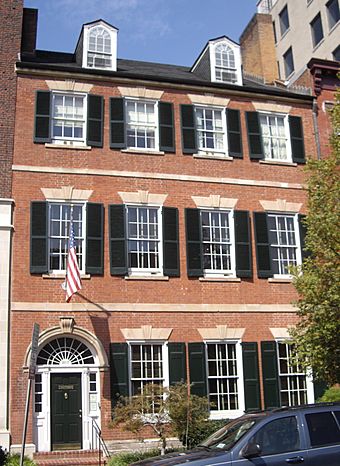Cleveland Abbe House facts for kids
|
Arts Club of Washington
|
|
 |
|
| Location | 2017 I Street, NW, Washington, D.C. |
|---|---|
| Built | 1802 |
| Architect | Timothy Caldwell |
| Architectural style | Federal |
| NRHP reference No. | 69000289 |
Quick facts for kids Significant dates |
|
| Added to NRHP | March 24, 1969 |
| Designated NHL | May 15, 1975 |
The Cleveland Abbe House is a very old and important building in Washington, D.C.. It is also known by other names like the Timothy Caldwell House and Monroe-Adams-Abbe House. This historic house was built in 1805. It shows a classic building style called "Federal architecture."
Many famous people have lived in this house. One of the most notable was James Monroe. He lived here when he was a high-ranking government official. He even stayed here for a short time as President of the United States. This happened after the White House was damaged during the War of 1812 and needed to be fixed. Another important resident was the writer and historian Henry Adams.
However, the house is especially famous because of Cleveland Abbe. He was a scientist who studied weather. He is known as the founder of the National Weather Service. Abbe lived in this house from 1877 until he passed away in 1916. Today, the building is home to the Arts Club of Washington.
Contents
What Does the Cleveland Abbe House Look Like?
The Cleveland Abbe House is located in Washington, D.C. It is northwest of the White House. You can find it on the north side of "I" Street. It is across from James Monroe Park.
Building Style and Features
The house is a three-story building made of red bricks. It is a type of building called a row house. This means it is part of a row of houses that share side walls. The roof has dormer windows, which are windows that stick out from the roof.
The front of the house is four sections wide. The main door is on the far left side. The windows are rectangular. They have stone sills and special stone designs above them called keystone lintels. A stone line, called a stringcourse, separates each floor.
The main entrance is very fancy. It has small windows on the sides of the door. It also has a large, half-round window above the door. Inside, the house still has many original features from when it was first built. These features show the "Federal period" style.
Who Lived in the Cleveland Abbe House?
The house was built by Timothy Caldwell between 1802 and 1805. It has been home to many important people throughout history.
James Monroe's Time in the House
James Monroe lived in the house from 1811 to 1817. During this time, he held very important jobs. He was the United States Secretary of State. He also served as the United States Secretary of War.
Monroe became America's fifth President in March 1817. The White House had been damaged during the War of 1812. So, the Cleveland Abbe House became the temporary Presidential home. Monroe lived there until the White House was fully repaired in September 1817.
Other Famous Residents
In the 1820s, the house was used by the British legation. This was like the British embassy at the time. Later, in 1860 and 1861, the famous historian Henry Adams lived here. He lived with his parents, Charles Francis Adams Sr. and Abigail Brooks.
Cleveland Abbe and the Weather Bureau
Cleveland Abbe was a very important scientist. He started the U.S. Weather Bureau, which is now the National Weather Service. He lived in this house from 1877 to 1909.
During the time Abbe owned the house, some changes were made. He added more height to the house, making it taller. He also removed some smaller buildings in the back. Then, he built more rooms onto the rear of the house.
After Cleveland Abbe passed away in 1916, the Arts Club of Washington bought the building. They still own it today.
Why is This House Important?
The Cleveland Abbe House is recognized as a very important historical site. It is listed on the National Register of Historic Places. It was added to this list in 1969. At that time, it was called the "Arts Club of Washington."
In 1975, the house was given an even higher honor. It was declared a National Historic Landmark. This special title recognizes its importance. It was named the "Cleveland Abbe House" for this honor. This shows its strong connection to Cleveland Abbe and his work.


